Every once in a while, a ghost town in Texas vanishes. It isn't swallowed by thick East Texas woods or submerged beneath a lake. It simply - POOF! - ceases to exist whatsoever. For want of a better term, I call these sites "vanished ghost towns."
In order for a ghost town to cling to "life," there must be some tangible remains of the old town still in existence. The Texas ghost towns of Jonesboro and Spivey are both hanging on by a thread with exactly one grave each, but sometimes not a single grave, not a single foundation, not even a bit of town masonry survives. That's when the ghost town in question has vanished once and for all.
The following is a short list of vanished ghost towns in Texas provided for your perusal. Enjoy.
ALABAMA (Houston County)
A former steamboat stop on the Trinity River, founded in the 1830s. On January 30, 1841, the Republic of Texas established Trinity College at Alabama, the first college anywhere in Texas. Alabama received its own post office in 1846, with A.T. Monroe as postmaster. The town apparently thrived for the next three decades as a shipping point for plantations in Houston County, but as the railroad slowly replaced the steamboat in the 1870s, Alabama's fortunes declined. The post office shut down in 1878, and most businesses and residents moved away from Alabama over the next decade. A school managed to operate in Alabama until 1897. By the time of the Great Depression, only a few scattered homes remained. The state established a Centennial Marker at the townsite in 1936, but today that site is a barren field on private property. Absolutely no remains of the old townsite appear to have survived.
JIMTOWN (Dallas County)
Those of you who ever stopped at Carl's Corner on I35E north of Hillsboro (before it turned into Willie's Place and then an oversized Petro) might appreciate the appeal of an older version of the basic concept that came to life during the administration of Rutherford B. Hayes. James "Jim" Bumpas operated a store just south of Dallas when he wasn't farming, and the store obtained its own post office in 1878. After that, Jimtown became a hub for farmers who needed medicines (Bumpas was also a country pharmacist) or general provisions for home and hearth. Throughout the town's history, Jimtown featured a livery stable, a wagon yard, a school that served 100 pupils, and a "union church" that served the needs of Baptists, Methodists, and Cumberland Presbyterians all under one roof. The school eventually evolved into the Jimtown Independent School District, incorporated in 1914. However, the steady growth of Dallas could not be curtailed, and the school district merged with Dallas in 1925. Jim Bumpas died in 1903, and his store lost its post office and transformed into a feed store until the wrecking ball destroyed the heart and soul of Jimtown in 1940. Nothing is known to survive from the old town; even Jimtown Road (which ran in front of the store) was renamed Clarendon Drive. If anyone has knowledge of the fate of the union church at Jimtown, please let me know.
QUAKERTOWN (Denton County)
The story of Quakertown deserves special mention due to the fact that this town was intentionally eradicated because of racial tension and prejudice. Quakertown was established in 1870 as a black community right in the middle of white Denton, and it set up its first school in 1878. Not long afterwards, Quakertown boasted a decent collection of restaurants, stores, and churches. However, Denton's white establishment sniffed at Quakertown's dirt roads and unpainted houses, and the nearby College of Industrial Arts in Denton (now Texas Woman's University) felt its close proximity to Quakertown threatened its chances at accreditation. In addition, Denton's political heavyweights started eyeing the creek that flowed through Quakertown as an ideal location for a new city park. Blacks and whites alike who spoke out against the plan found themselves on the receiving end of violent threats, and in 1922, faster than you could say "Jim Crow," Denton's white population voted to annex Quakertown and thus eradicate it, moving or demolishing all houses and buildings at the townsite and creating the Denton Civic Center Park where Quakertown once stood. The park has since been renamed Quakertown Park, but don't bother looking for any trace of the old town there - it's completely gone. One old Quakertown house, however, has been relocated to the Historical Park of Denton County; it now serves as the Denton County African American Museum.
WHO'D THOUGHT IT (Hopkins County)
As one person described it, "a forgotten town with an unforgettable name." Who'd Thought It was apparently organized as a farming community sometime after 1900 just north of fellow ghost town Sandhill (or south - I've heard it both ways) on Farm Road 1536. The first store at Who'd Thought It was operated by one Levi Kearny, and at its height during World War II, the small town had two stores and a number of scattered houses, and the local children attended school at Sandhill. In my own search for the town, I have yet to find any remnants of this community with the funny name, and I haven't even found Who'd Thought It on any maps in the archives of Hopkins County. I have apparently found a few scant remnants of Sandhill as well as a map giving its location as just north of Farm Road 1536 east of Tira, but if anyone has some information about the locale and fate of Who'd Thought It, please share.
Thursday, September 15, 2011
Sunday, September 11, 2011
Towash (Hill County) - August 2011 photos
First, a little extra history about outlaw John Wesley Hardin's infamous Christmas gunfight at Towash from the folks at The History Channel's website:
On Christmas Day in 1869, he went to the tiny town of Towash, Texas, seeking some holiday companionship and a good game of cards. Hardin apparently lost his happy holiday spirit when he argued with a man named James Bradley over a card hand. The confrontation escalated, and the men agreed to settle the dispute in a classic street face-off. Though such showdowns--or walkdowns, as they were sometimes called--were far less common than western books and movies suggest, they did occasionally occur, particularly among southern gunmen who continued to embrace the ideal of the gentlemen's duel. Late in the day, the two men faced each other in a deserted Towash street. Bradley shot at Hardin but missed. Hardin killed Bradley with bullets to the head and chest.
As stated earlier on this blog, the site of Towash was permanently inundated by Lake Whitney in 1951, never to surface again for the next 60 years. And now, photos from the lost ghost town of Towash:
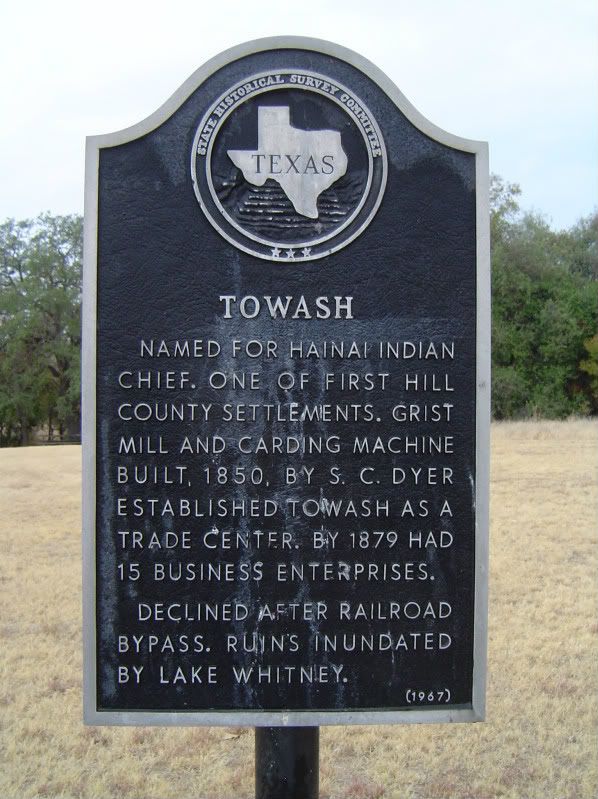
Historical Marker for Towash at Lake Whitney State Park, near what is possibly the largest collection of underwater ruins of the town
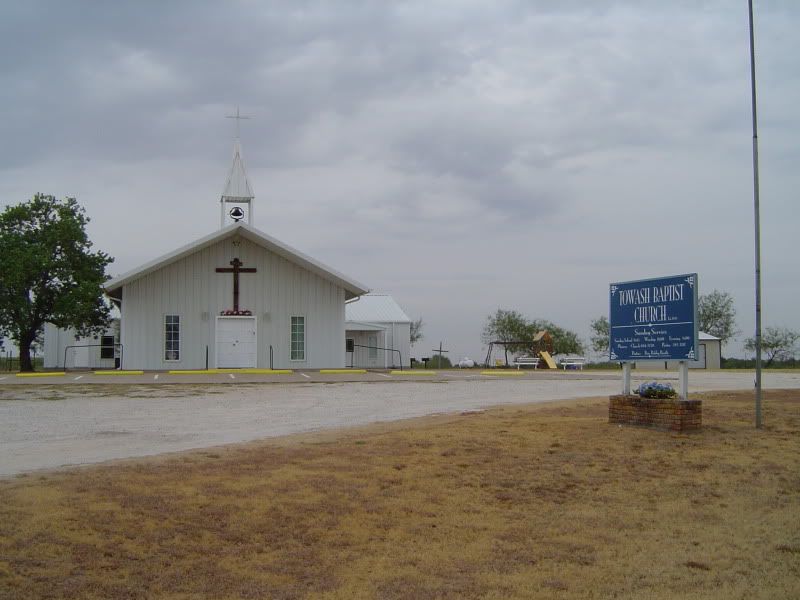
Towash Baptist Church in nearby Whitney, TX, built partially with materials from the old Towash site and still in use
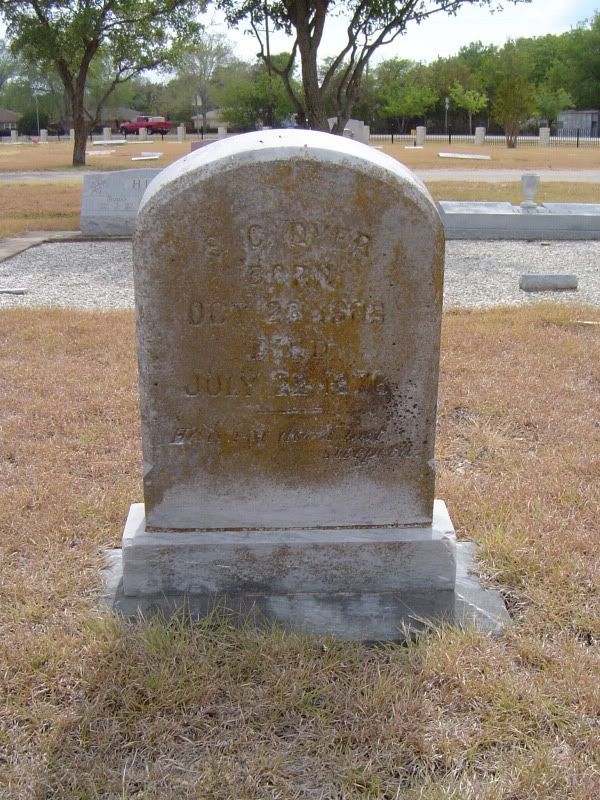
Tombstone of Simpson Cash Dyer, one of the town fathers of Towash, responsible for the town's gristmill and wool-carding machine; stone and grave relocated to Whitney, TX
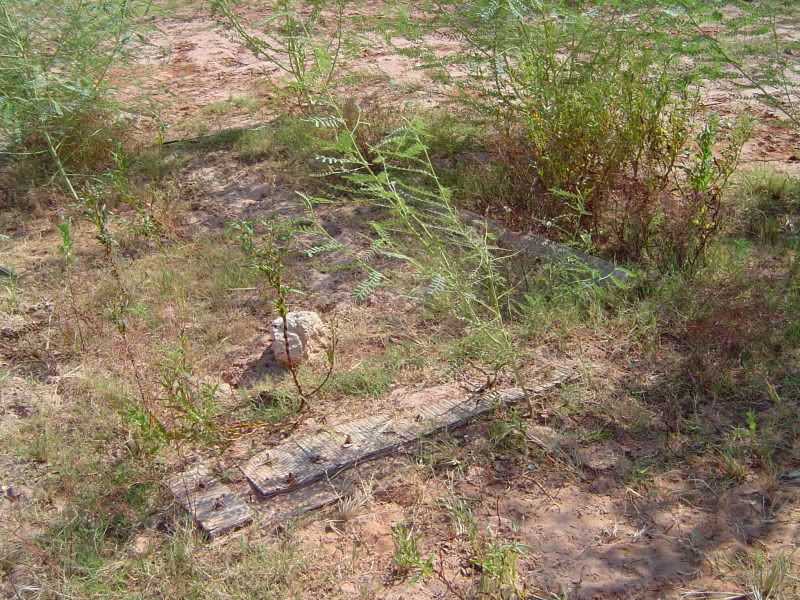
Wooden foundations of a small house or shack in Towash, recently emerging from Lake Whitney as a result of the 2011 drought
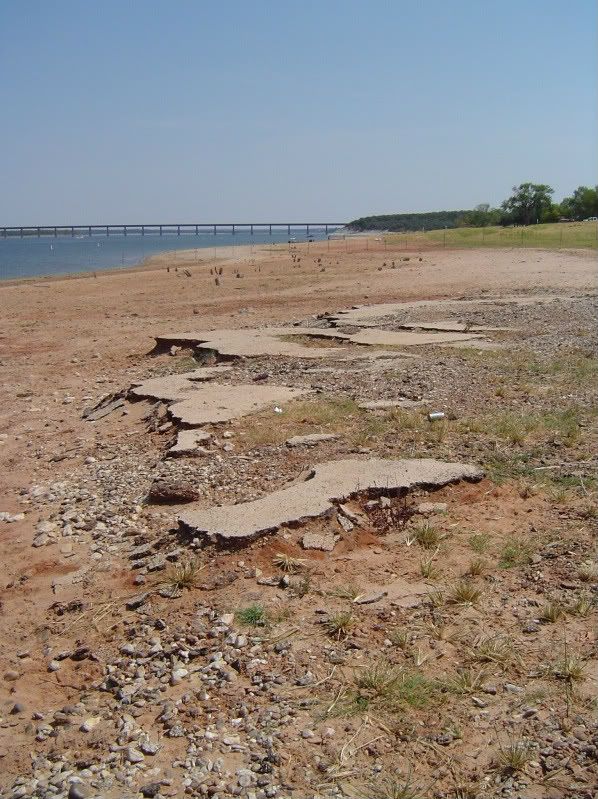
Remains of a long-submerged road through Towash, uncovered by the 2011 drought
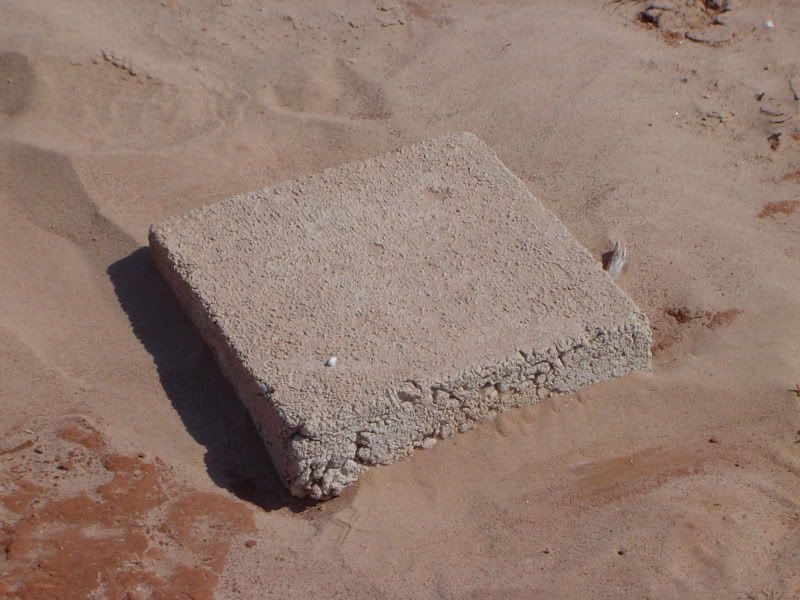
Enigmatic stone block sunk into the sandy soil at Towash, uncovered by the 2011 drought
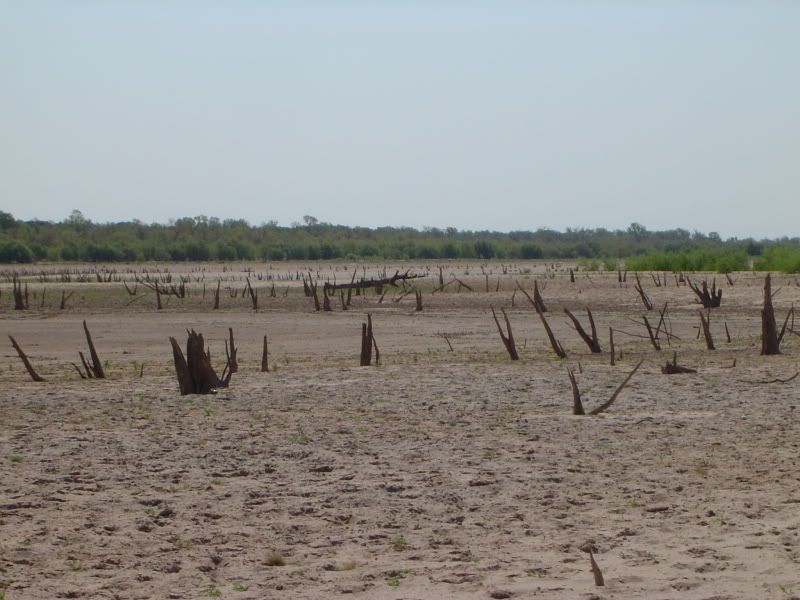
An utterly alien landscape of stumps of dead trees at the Towash site, uncovered by the 2011 drought
Will these be the only secrets of Towash that Lake Whitney yields? Possibly, but the current elevation of Lake Whitney as of 6:15pm Sunday evening (local time) is only 317.44 feet above sea level - it's supposed to be about 16 feet higher than that. As it is, however, the folks living at the lake are having to battle some fierce wildfires, and I'm in no mood to brave either the flames or more quicksand, so unless water levels drop even further, this may be all I can discover. But I could be wrong.
In the meantime, I hope you enjoyed these photos as much as I had rediscovering at least a few small pieces of the underwater ghost town of Towash!
On Christmas Day in 1869, he went to the tiny town of Towash, Texas, seeking some holiday companionship and a good game of cards. Hardin apparently lost his happy holiday spirit when he argued with a man named James Bradley over a card hand. The confrontation escalated, and the men agreed to settle the dispute in a classic street face-off. Though such showdowns--or walkdowns, as they were sometimes called--were far less common than western books and movies suggest, they did occasionally occur, particularly among southern gunmen who continued to embrace the ideal of the gentlemen's duel. Late in the day, the two men faced each other in a deserted Towash street. Bradley shot at Hardin but missed. Hardin killed Bradley with bullets to the head and chest.
As stated earlier on this blog, the site of Towash was permanently inundated by Lake Whitney in 1951, never to surface again for the next 60 years. And now, photos from the lost ghost town of Towash:

Historical Marker for Towash at Lake Whitney State Park, near what is possibly the largest collection of underwater ruins of the town

Towash Baptist Church in nearby Whitney, TX, built partially with materials from the old Towash site and still in use

Tombstone of Simpson Cash Dyer, one of the town fathers of Towash, responsible for the town's gristmill and wool-carding machine; stone and grave relocated to Whitney, TX

Wooden foundations of a small house or shack in Towash, recently emerging from Lake Whitney as a result of the 2011 drought

Remains of a long-submerged road through Towash, uncovered by the 2011 drought

Enigmatic stone block sunk into the sandy soil at Towash, uncovered by the 2011 drought

An utterly alien landscape of stumps of dead trees at the Towash site, uncovered by the 2011 drought
Will these be the only secrets of Towash that Lake Whitney yields? Possibly, but the current elevation of Lake Whitney as of 6:15pm Sunday evening (local time) is only 317.44 feet above sea level - it's supposed to be about 16 feet higher than that. As it is, however, the folks living at the lake are having to battle some fierce wildfires, and I'm in no mood to brave either the flames or more quicksand, so unless water levels drop even further, this may be all I can discover. But I could be wrong.
In the meantime, I hope you enjoyed these photos as much as I had rediscovering at least a few small pieces of the underwater ghost town of Towash!
Monday, September 5, 2011
Yet another occupational hazard
Quicksand.
While tromping around on the newly-expanded shores of Lake Whitney this weekend in search of more remains of the ghost town of Towash, yours truly stepped on what looked like relatively stable ground in a lakeside mud pit, only to watch his left leg sink up to his knee in quicksand in less than a second.
All is well - I remembered the "what to do" checklist in case of quicksand and freed myself from the liquified soil. Suddenly, I was done with exploring for the day.
I share this with you as a precaution for anyone who wants to go exploring ghost towns. Some of these vanished communities are located in out-of-the-way places that are home to rough terrain, poisonous spiders and snakes, and the occasional pool of quicksand. If you decide to go exploring, be prepared, be well-equipped - and be careful.
PS - Towash site photos coming soon, I promise!
While tromping around on the newly-expanded shores of Lake Whitney this weekend in search of more remains of the ghost town of Towash, yours truly stepped on what looked like relatively stable ground in a lakeside mud pit, only to watch his left leg sink up to his knee in quicksand in less than a second.
All is well - I remembered the "what to do" checklist in case of quicksand and freed myself from the liquified soil. Suddenly, I was done with exploring for the day.
I share this with you as a precaution for anyone who wants to go exploring ghost towns. Some of these vanished communities are located in out-of-the-way places that are home to rough terrain, poisonous spiders and snakes, and the occasional pool of quicksand. If you decide to go exploring, be prepared, be well-equipped - and be careful.
PS - Towash site photos coming soon, I promise!
Thursday, September 1, 2011
State park to open a short drive from Thurber
I just learned a few minutes ago that the Texas Parks and Wildlife Department has acquired a 3,300-acre tract for a future state park that will probably be located 6-7 miles away from the Erath County ghost town of Thurber. The land is located closest to the Palo Pinto County town of Strawn and straddles both Palo Pinto County and Stephens County.
According to Houston Chronicle reporter Shannon Tompkins, the TPWD in 2009 considered a tract of land closer to Thurber for development as a state park, but public health concerns related to tailings from the TPC&O coal mines that operated at Thurber a century ago scuttled the deal.
The park will probably open to the public in 3-5 years and includes an 80-acre lake and access to North Palo Pinto Creek.
According to Houston Chronicle reporter Shannon Tompkins, the TPWD in 2009 considered a tract of land closer to Thurber for development as a state park, but public health concerns related to tailings from the TPC&O coal mines that operated at Thurber a century ago scuttled the deal.
The park will probably open to the public in 3-5 years and includes an 80-acre lake and access to North Palo Pinto Creek.
Subscribe to:
Posts (Atom)